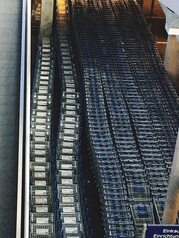The influence of labor supply on home valuation

The job offer in a region directly impacts the valuation of homes. In an increasingly competitive real estate market, understanding how job availability and nearby services influence appreciation is key to making informed decisions. This article will explore the relationship between the growth of job opportunities and property values, highlighting why choosing your location wisely can mean a safe and profitable investment in your home.
1. The connection between employment and real estate demand: Is it a powerful link?
The relationship between employment and real estate demand is undeniably powerful, as the availability of jobs in a region attracts people looking to settle in the area. When a city or neighborhood experiences significant job creation, there is an increase in population, which in turn raises the demand for housing. This phenomenon not only drives up property prices but also enhances quality of life by promoting the development of infrastructure and additional services, such as schools, hospitals, and recreational spaces. Thus, employment acts as a driver that propels both economic dynamism and home value.
Additionally, areas with a robust labor market tend to attract tenants and buyers willing to pay more for properties close to their workplaces. The convenience of living near employment becomes a decisive factor for many households. As competition for these desirable homes increases, so does their appreciation. Therefore, investors must carefully consider not only current labor trends but also future projections when assessing the potential profitability of a property. In summary, understanding this connection can be crucial for those looking to secure a safe and sustainable investment in the real estate sector.
2. Nearby services: the factor that attracts new residents.
Nearby services, such as schools, hospitals, shopping centers, and recreational areas, play a fundamental role in the decision to buy or rent a property. New residents seek not only a place to live but also a community that offers all the necessary amenities to facilitate their daily lives. The presence of these services can enhance the appeal of an area and, consequently, increase the value of the home. A good location that has easy access to these resources not only makes daily life more pleasant but also results in higher real estate demand.
Additionally, proximity to essential services is often related to a better quality of life. Families with young children will especially value having good schools and parks nearby where their children can play, while young professionals may prefer areas with efficient public transportation and a variety of leisure options. All of this contributes to creating a favorable environment that boosts both property value and demographic growth in the region. Therefore, considering nearby services when choosing a home is crucial to ensure not only personal comfort but also a solid investment in the future of the home.
3. How job creation raises the home equity.
The creation of jobs in a region not only improves the quality of life for its residents but also has a direct impact on home appreciation. When new job opportunities are generated, the influx of people looking to settle in the area increases significantly. This rise in housing demand can lead to a substantial appreciation in property prices, as more individuals and families are willing to pay to live near their workplaces. Additionally, an environment with greater economic activity tends to attract investments in infrastructure and services, which in turn further enhances the neighborhood's appeal.
On the other hand, job stability is a crucial factor that influences the perception of property value. Regions with high employment rates are often seen as safer for investment, as they offer a favorable economic outlook. This generates confidence among potential buyers, who prefer to purchase homes in areas with solid job prospects. In conclusion, the creation and sustainability of jobs not only benefit current residents by improving their quality of life, but also increase home values by attracting new residents and investors interested in a prosperous and dynamic location.
4. Success stories: neighborhoods that have thrived due to new job opportunities.
In various cities around the world, there have been cases of neighborhoods that have experienced a remarkable flourishing due to the arrival of new job opportunities. A paradigmatic example is the case of certain urban areas that, by hosting new companies and technology centers, have seen not only an increase in the number of available jobs but also in the quality of life of their inhabitants. The attraction of professional talent has incentivized the creation of additional services such as restaurants, shops, and recreational centers, transforming these spaces into desirable places to live. Thus, the valuation of homes rises considerably, as residents seek to benefit from the economic and social dynamism that these new environments offer.
Another emblematic case can be observed in areas where industrial parks or creative hubs have developed. These places often attract both young entrepreneurs and families seeking job stability and quality of life. The arrival of these people generates a growing demand for housing, which drives prices upward. Furthermore, investments in public infrastructure—such as transportation and education—become more common in response to population growth. As a result, neighborhoods previously considered peripheral begin to consolidate as vibrant and sought-after urban centers, thereby demonstrating how job opportunities can radically transform the local real estate landscape.
5. The impact of telecommuting on home valuation.
Remote work has transformed the way we value our homes, turning them into multifunctional spaces that serve not only as shelters but also as offices. This new work dynamic has led many people to reconsider their geographical location; it is no longer necessary to live close to the office if work can be done from anywhere. As a result, areas that were once considered peripheral have seen an increase in their valuation, as they offer an attractive combination of lower prices and higher quality of life. Homes with suitable spaces for working have become especially desirable, raising their demand and value in the market.
Moreover, remote work has driven the need for adequate infrastructure at home, which includes high-speed internet connectivity and environments conducive to concentration. This change is having a significant impact on the valuation of homes, as buyers are now seeking properties that offer these essential features. Urban areas are adapting to this trend by developing real estate projects that incorporate common spaces designed for collaborative work and recreational areas. In this context, choosing a well-located property becomes a key strategy not only to ensure daily comfort and functionality but also to secure a solid investment in a constantly evolving labor market.
6. Market study: analysis of regions with high job supply.
Market analysis is essential for identifying regions with a high labor supply, as these areas tend to attract a greater number of residents seeking employment. Cities or districts where job opportunities are abundant often experience significant demographic growth, which in turn generates a constant demand for residential properties. This increase in the working population not only raises interest in buying or renting homes but can also drive property prices up due to the limited available stock. Therefore, investing in areas with a strong labor base can lead to more sustained and robust appreciation over time.
Furthermore, the analysis must consider not only the quantity of available jobs but also the quality and stability of those jobs. Regions with diversified economic sectors and established businesses offer a safer environment for buyers and investors. Areas that stand out for having universities, technology centers, or emerging industries generally experience significant urban development, which can positively reflect on home valuation. Therefore, conducting a thorough study of the local labor dynamics not only helps to better understand the current real estate market but also provides valuable insights to anticipate future trends that may impact real estate investment.
7. Strategies for investing in areas with job potential.
To maximize return on investment in real estate, it is essential to identify areas with high labor potential. An effective strategy is to research locations that are experiencing economic growth, whether due to the arrival of new businesses or the expansion of existing sectors. Observing trends in job creation, as well as urban plans and upcoming infrastructure projects, can provide insights into the future development of a region. Investing in these areas not only ensures a constant demand for housing but can also lead to a significant increase in home value as the labor supply grows.
Another key strategy is to consider proximity to educational and technological centers. Regions near universities and educational institutions tend to attract young professionals and families seeking stability and job opportunities. Additionally, technology parks are often hubs of innovation and employment, creating an environment conducive to real estate growth. By investing in properties located near these labor hubs, one not only increases the potential for property appreciation but also its appeal to future tenants or buyers. Thus, an informed choice based on the analysis of the labor environment can be crucial in securing a solid and lasting investment.
8. The importance of public transportation in emerging work areas.
The importance of public transportation in emerging labor areas cannot be underestimated. An efficient and accessible transportation system facilitates the daily commute of workers, which in turn increases the attraction of companies to those areas. When employees can easily reach their workplaces, the time lost in commuting is reduced and the quality of life improves. Localities that have good transportation connections often see growth in their job offerings, which raises the demand for housing in those areas and, consequently, their appreciation.
Additionally, access to public transportation not only benefits those seeking employment; it is also a key factor for companies looking to establish themselves in a region. Proximity to subway, bus, or tram stations can be a crucial determinant for the location of new offices or factories. This creates a positive cycle where business investment further drives job creation and urban development. Therefore, when considering a property as an investment, taking into account the public transportation infrastructure can be decisive in ensuring high long-term appreciation.
9. Future trends: how will the relationship between employment and housing evolve?
The relationship between employment and housing is constantly evolving, driven by demographic, technological, and economic changes. As companies adopt more flexible work models, such as remote work, the demand for residential spaces in urban areas may be affected. People are beginning to value not only proximity to their workplaces but also access to services and an adequate quality of life. This suggests that rural or suburban areas could experience an increase in their value if they offer an attractive balance between remote work and a healthy environment.
Furthermore, the integration of sustainable technologies and shared spaces could redefine how homes are perceived based on available employment. The growing importance of environmental sustainability will influence both purchasing and rental decisions; those homes that align with these values could see a significant increase in their valuation. As the labor supply continues to adapt to new social realities, it is likely that the traditional concept of "home" will also change, thereby becoming an essential element for understanding the future of the real estate market.



